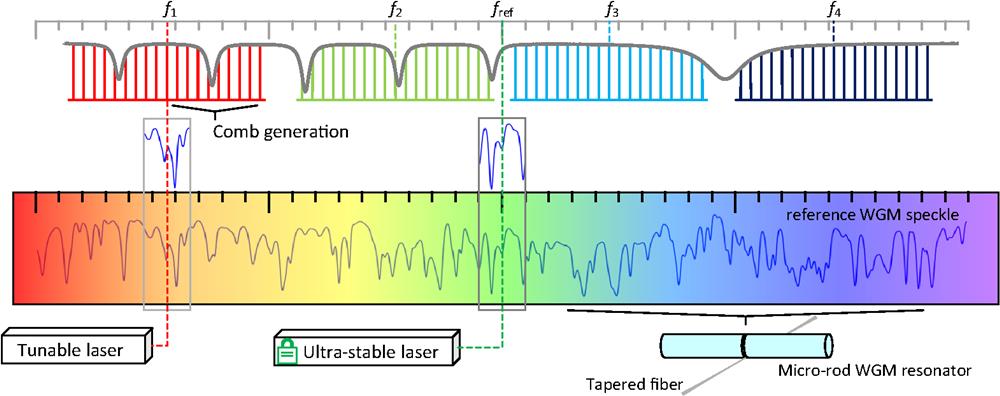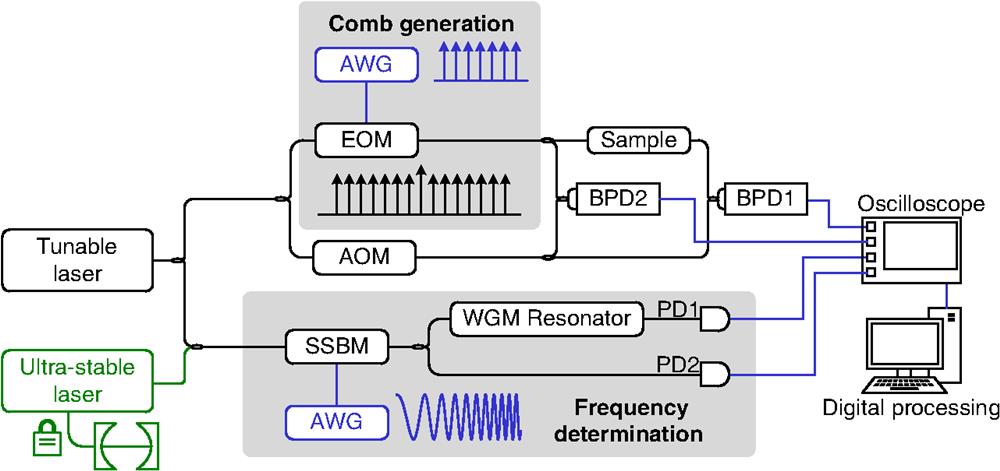Bingxin Xu, Yangyang Wan, Xinyu Fan, Zuyuan He, "Whispering-gallery-mode barcode-based broadband sub-femtometer-resolution spectroscopy with an electro-optic frequency comb," Adv. Photon. 6, 016006 (2024)
Search by keywords or author
- Advanced Photonics
- Vol. 6, Issue 1, 016006 (2024)

Fig. 1. Speckle-based spectroscopy with an EOFC. Reference WGM speckle, excited from a microrod resonator attached with a tapered fiber, is unique to be a “ruler” to determine the calibrated frequency of probe laser for electro-optic comb generation. The measurement bandwidth of narrowband ultrafine electro-optic comb is unlocked to the range of tunable probe laser while its center frequency is determined. An ultrastable laser for frequency calibration also eliminates external perturbation-induced shift of speckle. Ultrahigh-resolution spectroscopy with far extended bandwidth can be performed.

Fig. 2. The experimental setup of the speckle-based spectroscopy with an EOFC. AWG, arbitrary waveform generator; EOM, electro-optic modulator; SSBM, single-sideband modulator; WGM, whispering-gallery-mode; PD, photodetector; BPD, balanced photodetector.
Fig. 3. Frequency determination for a fiber laser with a resolution of 100 kHz in 120 GHz bandwidth. (a) The speckle was recorded in 0.8 ms, corresponding to a frequency range of 8 GHz. (b) A zoom-in figure of (a) in 0.05 ms. (c) Cross-correlation result between the measurement speckle and the reference speckle over a bandwidth of 120 GHz. (d) and (e) are zoom-in correlation peaks of the reference laser and the fiber laser. The frequency of the tunable laser is determined to be 193.4046926 THz. The FWHMs of two peaks are both about 41 MHz. (f) Frequency readouts of the fiber laser with frequency modulation. (g) Fourier transformation of frequency readouts. The amplitude and frequency of the modulation are 100 kHz and 250 Hz, respectively. The sampling rate of the frequency readout is 1.25 kHz.
Fig. 4. Spectroscopic measurement of the reflection spectrum of a fiber F–P cavity. (a) Resolved spectrum of the EOFC in linear scale with a bandwidth of 2.5 GHz by Fourier transformation of data in 1 ms recording time. (b) Zoom-in figure of (a) in the box with resolved comb lines and one recorded resonance. The line spacing, corresponding to the spectral resolution, is 100 kHz. (c) The reflectance spectrum of a fiber F–P cavity in 117 GHz bandwidth. The spectrum is composed of 47 acquisitions by changing the center frequency of the tunable laser. Each acquisition contains 25,000 resolved comb lines with 100 kHz resolution over 2.5 GHz bandwidth. Two acquisitions with adjacent center frequencies are drawn in red and blue. (d) Zoom-in figure of (c) for an overlapped region in 0.8 GHz. The free spectral range of the fiber cavity is measured to be 105.6 MHz. (e) Zoom-in figure of a fiber cavity resonance. The linewidth of the resonance is 250 kHz, corresponding to a Q -factor of
Fig. 5. Frequency determination for the external cavity laser diode with a resolution of 1 MHz in 9.5 THz bandwidth. (a) Cross-correlation result between the measurement speckle and reference speckle over a bandwidth of 9.5 THz. (b) Zoom-in correlation peak of the ECDL. The frequency is determined to be 190.164017 THz. (c) Zoom-in correlation peak of the reference laser. The FWHMs of two peaks are 31 and 54 MHz, respectively. (d) Frequency readouts of the ECDL with frequency modulation. (e) Fourier transformation of (d). The amplitude and frequency of the modulation are 1 MHz and 2.5 kHz, respectively. The low-frequency region is the frequency noise of the ECDL. The averaged frequency error of ECDL in 1 ms (recording time for following spectroscopy experiment) is 0.48 MHz. The sampling rate of frequency determination is 12.5 kHz.
Fig. 6. Spectroscopic measurement of the transmission spectrum of HCN gas cell with 1 MHz resolution. (a) The reference database and (b) the measurement result of HCN transmittance spectrum in 4.74 THz bandwidth (corresponding to 38 nm) with a resolution of 1 MHz. The result is composed of 1890 acquisitions. Each acquisition contains 2350 resolved comb lines with a line spacing of 1 MHz in 1 ms recording time. (c) Residual error between (a) and (b). The standard deviation is 0.0069, corresponding to an SNR of 144.
Fig. 7. Long-term stability of WGM resonance and WGM-based wavemeter in 10 h. (a) Linewidth, depth, and center frequency evolution of the WGM resonance circled in (b). (b) A portion of WGM speckle. (c) Frequency bias obtained from the readout of stable laser for calibration. (d) Cross-correlation coefficients, which are always >0.64. (e) and (f) Cross-correlation peaks pointed by arrows in (d).
Fig. 8. Cross-correlation coefficient versus the change of Q -factor and free spectral range in simulation. The quantitative bound is illustrated in red, where the correlation coefficient is 0.5.
Fig. 9. Performance metric chart of various spectroscopic methods – EOFC, dual-comb spectroscopy, reconstructive spectrometers – using resolution and bandwidth constraints.

Set citation alerts for the article
Please enter your email address



